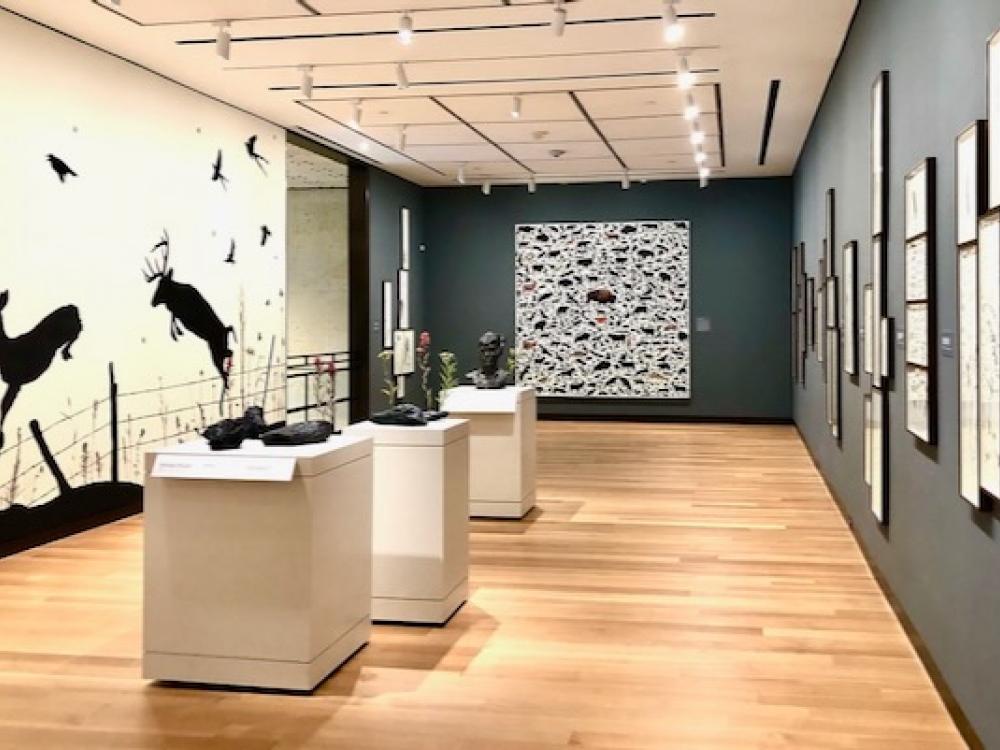
Artist James Prosek captures the embattled Texas prairie in a remarkable exhibit at the Amon Carter Museum of American Art on display through Jan. 28. Photo by Amy Martin.
Dec. 8, 2023
Immersing myself in the Amon Carter Museum exhibit Trespassers: James Prosek & the Texas Prairie, I kept hearing Joni Michell's lyrics from Big Yellow Taxi: "Don't it always seems to go, that you don't know what you've got until it's gone."
Prosek had the same thought a couple of years ago. He traipsed through more than a dozen Texas prairies with watercolors, canvas and easel in hand. Some were unplowed virgin remnants, remaining uncharged for thousands of years. Other prairies were degraded by overgrazing or planted with imported grasses.
Trespassers occupies a small gallery in the Fort Worth museum, enhancing the exhibit's intimacy. The show is immersive and profoundly moving.
The clever arrangement of watercolors and other artwork emphasize the artist's message. Drawings of tall plants are divided into several frames, echoing the fragmentation of prairies. The pieces arranged in a cross shape are of plants from a cemetery.
 The arrangement of drawings emphasizes the fragmentation of the prairie. Photo by Amy Martin.
The arrangement of drawings emphasizes the fragmentation of the prairie. Photo by Amy Martin.
"His paintings from these prairie fragments are bridges into a most beautiful world, like the trout he painted as a young man," said Matt White, author of Prairie Time: A Blackland Portrait. “It is a world that few today can comprehend."
The exhibit is astounding — and not just for prairie nerds. The art is detailed and exquisitely done in multiple mediums — from bronze and clay to line drawings, watercolors and acrylic paintings. It's the most creatively staged display of art I've seen in many years. Bravo to the Amon Carter Museum of American Art for genuinely capturing the art and story of our native landscape.
Two sets of immense artworks anchor the exhibit. On one end are many small silhouettes and paintings of what most people associate with the West — cowboys, horses, etc — which contrasts with the much larger similar artwork on the opposite wall of the wildlife of the West, from bison to birds.
Gallery notes from the show compares the Trans Pecos — where wildlife habitat remains relatively intact and which is illustrated by bighorn sheep perched on a crag — to the Blackland Prairie — segmented and heavily urbanized, where the wildlife are running for their lives as exemplified by white-tailed deer racing over a barbed-wire fence.
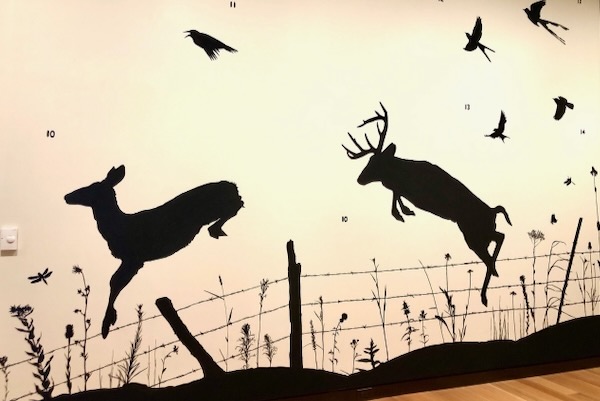 Wildlife of the Blackland Prairie is shown fleeing for their lives from development in this large-scale painting. Photo by Amy Martin.
Wildlife of the Blackland Prairie is shown fleeing for their lives from development in this large-scale painting. Photo by Amy Martin.
In the gallery center is a sculpture of a charred block of wood with wildflowers emerging from it. But the wood is not wood. It's bronze. The plants are not dried. They're clay. Remarkable realism depicts the rejuvenation of wildfires, which Prosek calls "the ultimate trespasser" on the prairie, noting that once areas developed, wildfires were suppressed and excluded.
Local naturalists offered their responses to the show.
"James Prosek's sculptures were lifelike and so delicately rendered that I wanted to take them home,” said Kim Conrow, prior president of the Native Plant Society of Texas. “They are beautiful. The large square mural had repeating animals with mostly different shapes. It was visually appealing and held our interest for quite some time. The flora illustrations consisted of multiple frames per grouping, which made us study the plant parts in detail.”
Don Young, prairie steward at Tandy Hills Natural Area in Fort Worth, also had high praise for the exhibit.
"I was most impressed by the exquisite, colored drawings on paper of our native wildflowers and grasses, things I have closely observed in the wild for many years,” said Young. “Like Audubon's bird drawings, they show us their beauty in textbook detail.”
PRAIRIE POSSE
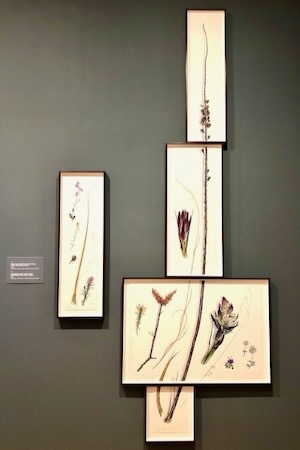 Imaginative displays of James Prosek's drawings emphasize both the native plants’ height and how the prairie is increasingly segmented. Photo by Amy Martin.
Imaginative displays of James Prosek's drawings emphasize both the native plants’ height and how the prairie is increasingly segmented. Photo by Amy Martin.
The exhibit features plants from several North Texas prairies, including Clymer Meadow Preserve and White Rock Lake prairies.
A tribe of passionate prairie enthusiasts assisted Prosek, including Brandon Belcher of The Nature Conservancy and author White.
"We bonded over a love of the genus Castilleja — the paintbrushes — which we both realized spoke to us subconsciously," said White.
During the year and a half that Prosek worked on this project, White said they texted or spoke almost every day.
“We made several trips together across six prairie states looking for fragments of prairie and fragments from those for him to paint. I helped him see the prairie through my eyes, and as a reward, I saw the prairie fresh again through his."
White will contribute an essay for Prosek's book about the exhibition, to be published by Rizzoli Press in 2024.
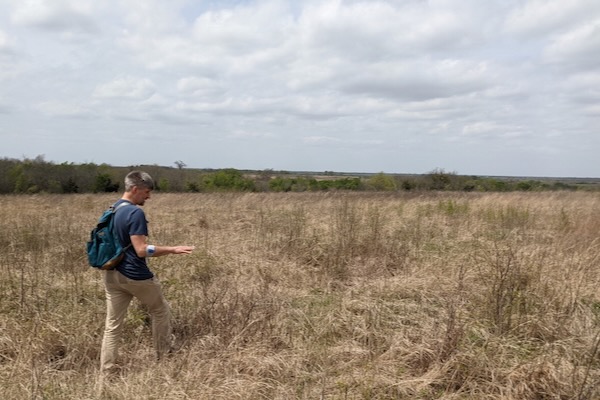 Artist James Prosek on a visit to Clymer Meadow Preserve in Celeste, northeast of Dallas. Photo courtesy of Spencer Wigmore.
Artist James Prosek on a visit to Clymer Meadow Preserve in Celeste, northeast of Dallas. Photo courtesy of Spencer Wigmore.
"Before I came to Texas, I had never met people who had such a deep passion for… grass,” wrote Prosek in an essay for the museum. “Visiting remnant prairies (areas of native grasslands that had never been overgrazed or plowed) and restoration sites (areas where landowners are trying to bring native grasslands back) in the Texas Hill Country, single strands of little bluestem sent our hosts — from landowners and managers to landscape architects and biologists — into fits of rapture. Texans' love of grass proved contagious."
"I can't say I had ever looked at grass closely before — or at all. Where I grew up in Connecticut and still live, grass to me was just stuff that grew on highway medians or in hay meadows," continued Prosek in the essay. "Now, I was staring at a single six-foot-tall stalk of big bluestem, wondering how to creatively capture what I beheld — a range of purples and reds and greens, sometimes with a glaucous haze, like on a plum, or with a waxy, glossy surface. The grasses were beautiful, insanely so."
FUTURE OF THE PRAIRIE
Conrow said the exhibit’s title Trespassers is perfect for a show that aims to make people value this habitat.
“We trespass when we urbanize and destroy the prairie. We all know how much Texans dislike trespassers," said Conrow.
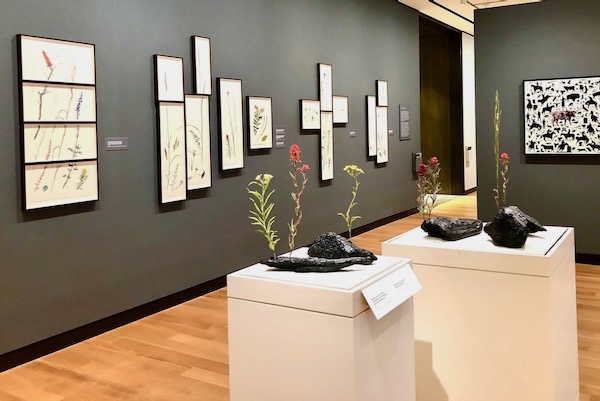 Trespassers incudes watercolor, line drawings, and sculptures. Photo by Amy Martin.
Trespassers incudes watercolor, line drawings, and sculptures. Photo by Amy Martin.
"Having watched prairies become increasingly appreciated over the past 20 years, it was a joy seeing prairie plants and wildlife cover museum walls on a grand scale,” said Young “The exhibition, which widens the audience, also fits my philosophy that, to get people to appreciate something they first have to know it exists, which can lead to a desire to take care of it. Perhaps, in some small way, the exhibition may help slow the ravaging of this vital ecosystem.”
Less than 1 percent of the Blackland Prairie remains, the remainder having been converted to agriculture or developed. One statewide land trust is devoted to saving what's left, Native Prairies Association of Texas, either through gifts of land, purchasing through fundraising drives or working with landowners to place a conservation easement on their prairie property.
Two Native Prairies Association of Texas chapters are actively working to rehabilitate public prairies and educate on the vital role they place in preserving pollinators, reducing the urban heat island effect and maintaining air and water quality. The Blackland Prairie Chapter covers Dallas and several other counties, and the Fort Worth Chapter serves Tarrant and other counties to the West.
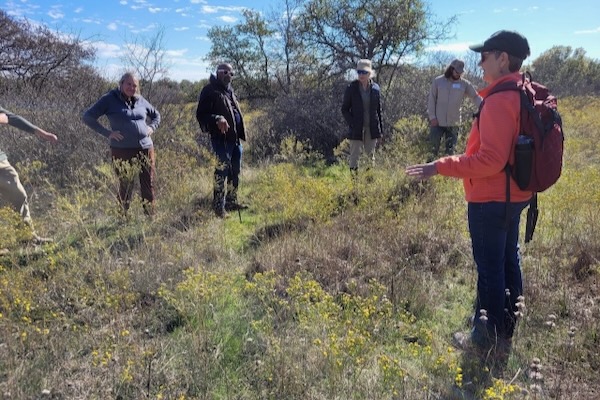 Suzanne Tuttle leads a class about the Fort Worth Prairie. Photo by Amy Martin.
Suzanne Tuttle leads a class about the Fort Worth Prairie. Photo by Amy Martin.
Learn more on how to steward prairies with the Native Plant Society of Texas course, Stewardship of Native Plant Communities, on Saturday, Jan. 20 via Zoom. The course is taught by Suzanne Tuttle of the Fort Worth Native Prairies Association of Texas chapter.
MORE NATURE EXHIBITS AT AMON CARTER
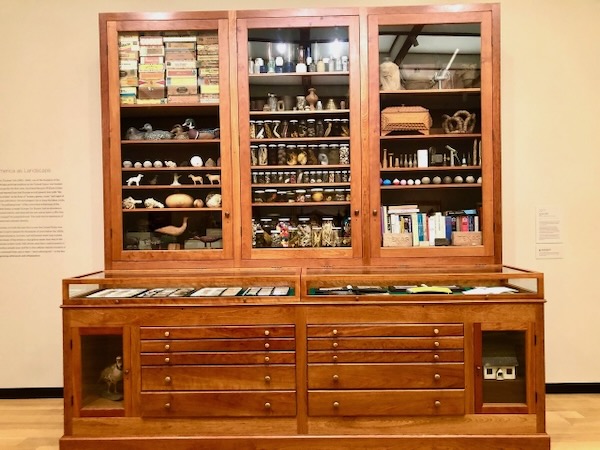 The "Texas Cabinet," an art installation by Mark Dion, is also on display the Amon Carter. Photo by Amy Martin.
The "Texas Cabinet," an art installation by Mark Dion, is also on display the Amon Carter. Photo by Amy Martin.
A fascinating art installation on the same floor as Trespassers is Mark Dion's The Texas Cabinet. The piece is entirely Texas on so many natural and cultural levels. You can even pull out the drawers and see more items.
Viewers can disappear into the Texas Cabinet’s intricate arrangement. Photo by Amy Martin.
Also, take a moment with Tipping Point: Echoes of Extinction (through May 1) by Elizabeth Turk. The interactive outdoor exhibit overlooking to the museum's front lawn turns the songs of extinct and endangered (or formerly endangered) birds into sculpture based on the songs' frequencies.
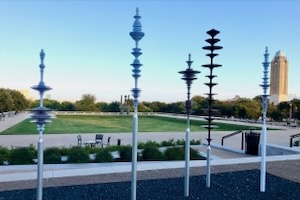 Point your phone's camera at the QR codes to hear the birdsongs (or, in the case of extinct birds, their closest relative).
Point your phone's camera at the QR codes to hear the birdsongs (or, in the case of extinct birds, their closest relative).
The Amon Carter exhibit "The Tipping Point: Echoes of Extinction" brings a visceral realness to the problem of extinction. Photo by Amy Martin.
Trespassers: James Prosek & The Texas Prairie
About: Trespassers: James Prosek and the Texas Prairie investigates the allure of Texas’s grasslands, while raising broader questions about the boundaries that shape, limit, and define prairie spaces in the present day.
When: The exhibit runs through Jan. 28.
Where: The Amon Carter Museum of American Art https://www.cartermuseum.org/, 3501 Camp Bowie Blvd, Fort Worth.
Artist Talk: James Prosek on Jan. 11 from 6 p.m. to 7:30 p.m. It will be a live recording of the podcast Mountain & Prairie https://mountainandprairie.com/, with host Ed Roberson talking with Prosek about his exhibition. An audience Q&A will follow their conversation. Register.









